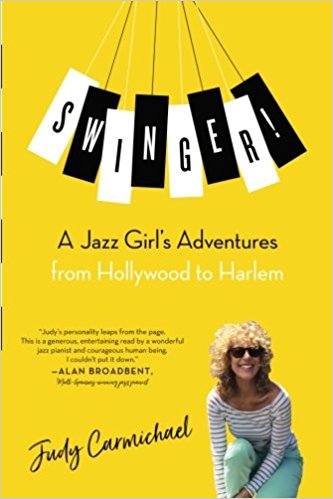Home » Jazz Articles » Bailey's Bundles » Judy Carmichael: All Taken in Stride
Judy Carmichael: All Taken in Stride
 Swinger! A Jazz Girl's Adventures from Hollywood to Harlem
Swinger! A Jazz Girl's Adventures from Hollywood to Harlem Judy Carmichael
276 Pages
ISBN: # 978-1979764414
CreateSpace Independent Publishing Platform
2017
Pianist and vocalist Judy Carmichael is a jazz girl who has been performing professionally for nearly 40 years. In her memoir Swinger! A Jazz Girl's Adventures from Hollywood to Harlem she relates being told of her cervical cancer diagnosis this way:
Doctor: "I must say you are taking this remarkable well, Judy."
Carmichael: "I'm a jazz musician, doctor. To tell you the truth, this isn't the worst thing that's ever happened to me."
And, that brief discourse brightly illuminates both the charm and steel that is Judy Carmichael.
After biographies and memoirs of the ilk of Art and Laurie Pepper' Straight Life: The Story Of Art Pepper (De Capo Press, 1996); Hampton Hawes' Raise Up Off Me: A Portrait of Hampton Hawes (Da Capo Press, 2001), and Anita O'Day's High Times Hard Times (Limelight, 2004), it is nice to read an upbeat, positive, and sunny account of a life well lived...and continuing to be lived, in music.
Carmichael is a jazz pianist, but just not any jazz pianist. She is a stride pianist. Harlem Stride Piano, known in the vernacular as stride, is a jazz piano style that developed in New York City in the 1920s and '30s. The style is characterized by the left hand playing a four-beat pulse with a single bass note, octave, major seventh or major tenth Interval on the first and third beats, and a chord on the second and fourth beats. This rhythmic pattern is also often reversed by placing the chord on the downbeat and bass note(s) on the upbeat. The stride style of piano playing was pioneered by James P Johnson (1894-1955), Willie "The Lion" Smith (1893-1973), Thomas "Fats" Waller (1904—1943), and Luckey Roberts (1893-1968). Other masters included Duke Ellington, Count Basie, Art Tatum, and Oscar Peterson. The later Keepers-of-the-flame comprise Thelonious Monk, Ralph Sutton, Dick Wellstood, Dick Hyman, and our present Judy Carmichael.
Born as Judith Lea Hohenstein and raised in California, Carmichael was part of suntanned close-knit family whose thread is pulled through this story like a triumph. Taught piano by her mother, Carmichael went on to debut professionally at 19 years old performing doing cocktail cruises in Newport Beach, California. In 1980, Carmichael released the first of her thirteen recordings to date, Two Handed Stride (Progressive Records), was recorded with Basie sidemen Marshal Royal, Freddie Green, Red Callender, and Harold Jones, and was nominated for a Grammy Award. Carmichael performed throughout the world in a variety of formats and with many notable musicians. She hosted a jazz radio show for many years, competing with Marian McPartland's Piano Jazz, appearing with McPartland in 1988. Perhaps her greatest professional complement came from Count Basie, who supplied her nick mane, "Stride."
Relayed in her bright, matter-of-fact style, Carmichael details her struggle with and recovery from cervical cancer, a harrowing tale told from the perspective of positive foresight and optimism that is not characteristic of the jazz life. Presently at 60-years old, Carmichael can generate more memoire fodder that is sure to delight in her next text outing.
 Judy Carmichael
Judy Carmichael Come and Get It
C&D Productions
2008
Stealthily included with the copy of Swinger! was Carmichael's 2008 self-produced release Come and Get It. Sometime after completing her cancer treatment, Carmichael added vocals to her already considerable musical repertoire. Is Come and Get It is the evidence of this. She and full band perform a wide range of stride pieces from Eubie Blake to Fats Waller to Duke Ellington and ever one of Carmichael's own, "Boisedale Blues" written in the sepia-tinged style that made and kept her famous. I believe that it is important to note that what Carmichael has done for the whole of her career is preserve a craftsman brand of piano playing, one that was once reserved for only the finest and most accomplished of performers, the style most often used for "cutting contests" between the titans of the piano. This is not music to be merely sniffed at but inhaled deeply to fully appreciate the tradition from which it came. One has to be glad for Judy Carmichael and her dedication to this songcraft.
< Previous
Oh My, Those Boys!
Next >
In the Wake
Comments
Tags
Bailey's Bundles
Judy Carmichael
C. Michael Bailey
duke ellington
Count Basie
Art Tatum
oscar peterson
Thelonious Monk
Ralph Sutton
Dick Wellstood
Dick Hyman
Marian McPartland
For the Love of Jazz
 All About Jazz has been a pillar of jazz since 1995, championing it as an art form and, more importantly, supporting the musicians who create it. Our enduring commitment has made "AAJ" one of the most culturally important websites of its kind, read by hundreds of thousands of fans, musicians and industry figures every month.
All About Jazz has been a pillar of jazz since 1995, championing it as an art form and, more importantly, supporting the musicians who create it. Our enduring commitment has made "AAJ" one of the most culturally important websites of its kind, read by hundreds of thousands of fans, musicians and industry figures every month.


















